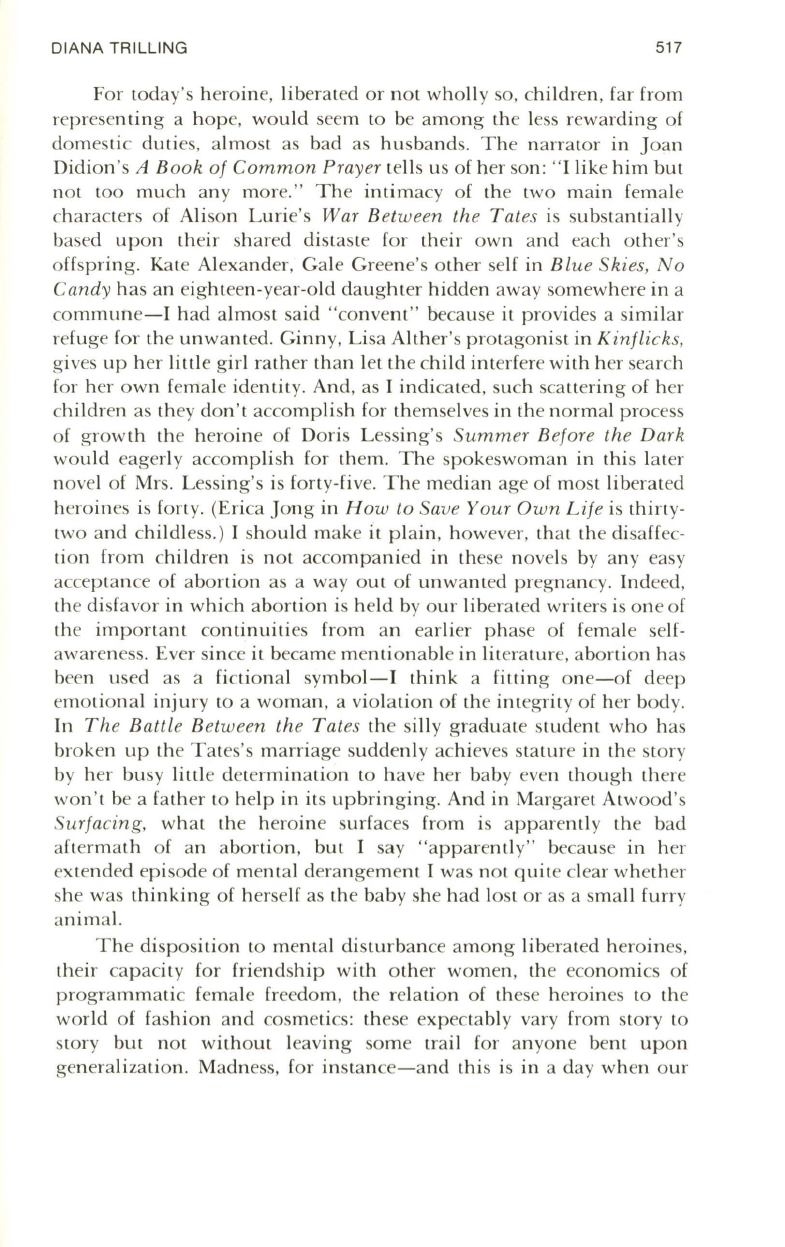
DIANA TRILLING
517
For today's heroine, libera ted or n o t wholl y so, children , far from
representing a hope, would seem to be among the less rewa rding of
domes ti c duti es, almost as bad as hu sbands. The narra tor in Joan
Didion 's
A Book of Common Prayer
tells us of her son : " I like him but
no t too much any more." The intimacy of the two main female
ch aracters of Alison Lurie's
War Between the T ates
is substanti a ll y
based upon their shared distas te fo r their own and each oth er's
offsp ring. Ka te Al exander, Gale Green e's o ther self in
Blue Skies, No
Candy
h as an eighteen-year-o ld dau ghter hidden away somewhere in a
commune-I had almos t sa id "convent" because it provides a simil ar
refuge for the unwanted . Ginny, Lisa Alther's p rotagoni st in
Kinflicks,
gives up h er littl e girl ra ther than let the child interfere with h er sea rch
for her own female identity. And, as I indi cated, such sca ttering of her
children as they don ' t accompli sh for themselves in the normal process
of grow th the hero ine of Dori s Less ing's
Summer Before the Dark
would eagerl y accompli sh for them . The spokeswoman in thi s la ter
novel of Mrs. Lessing's is forty-fi ve. The medi an age of mos t libera ted
hero ines is fo rty. (E rica J on g in
How to Save Y our Own L ife
is thirty–
two and childl ess.) 1 should make it pl ain, however, tha t the di saffec–
ti on from children is no t accompanied in these novels by an y easy
acceptan ce of abo rtion as a way out of unwanted pregnancy. Indeed ,
the di sfavor in whi ch abortion is held by our libera ted writers is on e of
the important continuiti es from an earli er phase of female self–
awareness. Ever since it became menti on able in litera ture, abortion h as
been used as a fi ctional symbol-I think a fittin g one- o f deep
emoti ona l injury to a woman , a viol a tion of the integrity of her bod y.
In
Th e Battle Between the Tat es
the sill y gradua te student who has
broken up the T a tes's ma rri age suddenl y achieves sta ture in the story
by her busy little determina tion to h ave her baby even though there
won 't be a fa ther to help in its upbringing. And in Ma rgaret Atwood 's
Surfacin g,
wh a t the heroine surfaces from is apparentl y the bad
afterma th of an abo rti on , but 1 say "apparentl y" because in h er
extended epi sode of mental derangement I was no t quite cl ear whether
she was thinking o f herself as the baby she h ad lost or as a small furry
animal.
T he disposition to mental disturbance amon g libera ted heroines,
their cap acity for fri endship with other women , the economics o f
p rogramma tic female freedom, the rela ti on of these heroines to the
world o f fashion and cosmetics: these expectabl y vary from story to
story but no t without leaving some trail for anyone bent upon
gen eraliza ti on . Madness, for instance- and thi s is in a day when our


